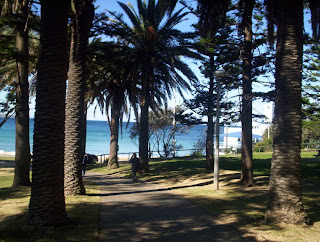Maroubra Beach stretches for approximately 1 km on Maroubra Bay. Mahon Pool is located north of the beach, near Mistral Point. There are two surf clubs at Maroubra: Maroubra Surf Life Saving Club and South Maroubra Surf Life Saving Club. Arthur Byrne Reserve sits behind both these clubs. A skating park is located at the southern end of Maroubra Beach.
Maroubra has a few large parklands, the most popular being the reserve along the waterfont at Maroubra Beach, called Arthur Byrne Reserve. The reserve has an enclosed children's playground to the north of the blue Pavilion building at North Maroubra, close to the car park. There are barbecue facilities and tables for picnickers. There are public ablution facilities inside the blue Pavilion building. Arthur Byrne Reserved is the home to the Oktoberfest/Fun Run every year.
Heffron Park, on Fitzgerald Avenue and between Bunnerong Road and Robey Street is a particularly large park. It accommodates the Des Renford Aquatic Centre with indoor and outdoor pools, tennis courts, sports fields, parklands, and a two kilometre cycle track which is used for time trials and is accessible for public use at other times.
Nagle Park, on Wild Street between Walsh Street and Holden Street, is a flat parkland equipped for use as a sports facility. It is also a popular dog park, with dogs permitted off-lead.
Snape Park, on Snape Street between Hannan and Percival Streets is equipped with popular tennis facilities and sports fields and is frequently used for organised sporting events.
Central Park, at the corner of Cooper and Storey Streets, has a flat parkland with an excellent bicycle track for young children built of smooth concrete. This park also has playground equipment.
Coral Sea Park, south of Yorktown Parade, has a flat area that provides several sports fields. It has playground equipment at its south end.



























